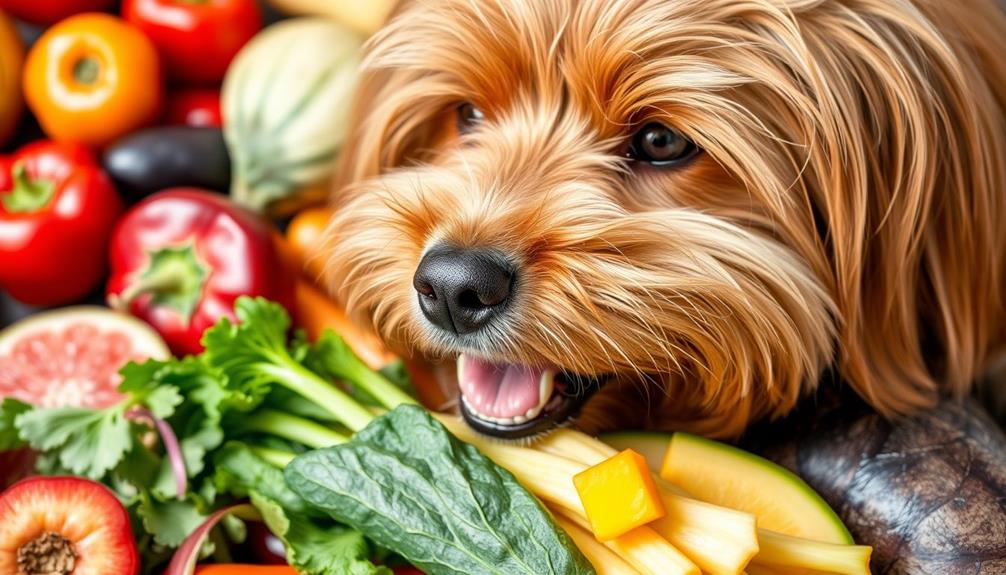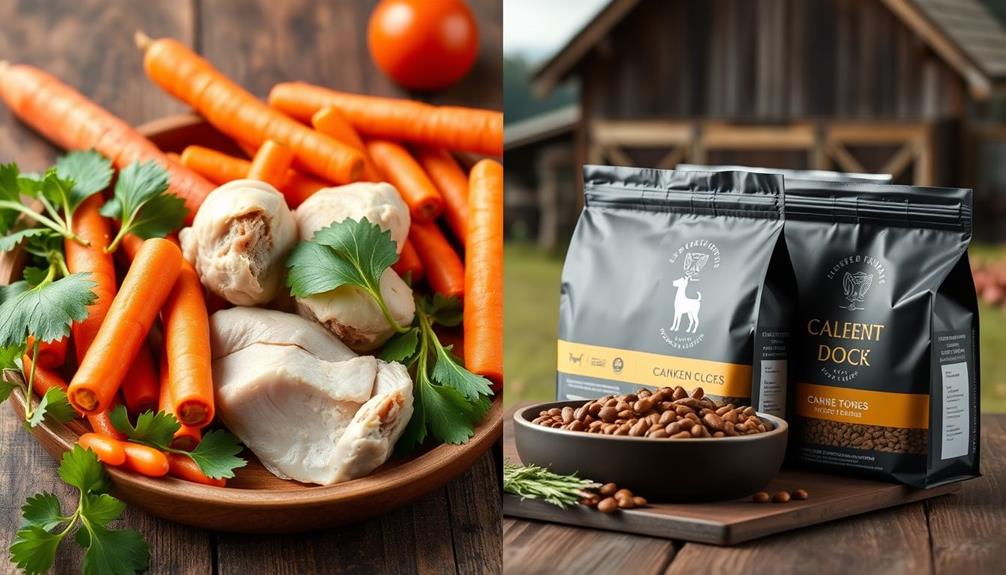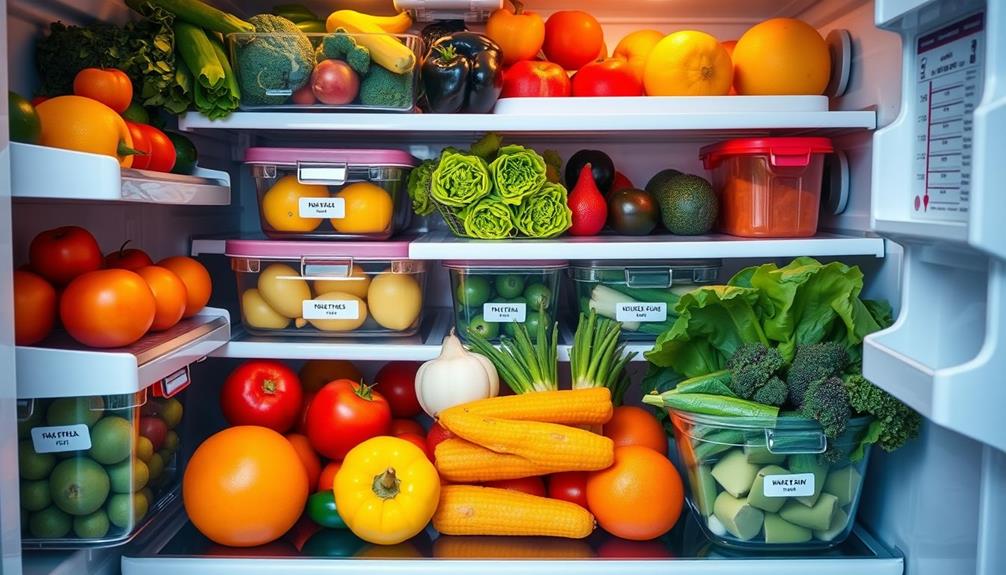If your dog won't eat raw food, several factors could be affecting their appetite. Picky eaters often prefer kibble, while stress or changes in routine can lead to food refusal. It's important to shift gradually by mixing raw food with kibble to ease adjustment. Experimenting with different proteins and warming meals can enhance palatability. Creating a consistent feeding routine and monitoring your dog's preferences can also help spark interest. Keep an eye on their health, as a sudden loss of appetite might signal a need for veterinary advice. There's more to uncover about making raw feeding work for your dog!
Key Takeaways
- Gradually introduce raw food by mixing it with kibble to ease digestive adjustment and enhance acceptance.
- Experiment with various protein sources to identify your dog's favorites and increase interest in raw meals.
- Slightly warm thawed raw food to enhance aroma and flavor, making it more appealing to your dog.
- Maintain a consistent feeding routine and engage your dog with enrichment activities to create a positive mealtime atmosphere.
- Consult a veterinarian if your dog refuses to eat for over 24 hours, as this may indicate health concerns.
Understanding Appetite Challenges
When it comes to your dog's appetite, various factors can play a role in their reluctance to eat raw food. You might find your dog not eating raw meals due to their picky eating habits or simply being more accustomed to kibble. This familiarity can create appetite challenges when introducing a raw food diet.
Additionally, some dogs may have sensitivities to certain ingredients found in raw diets, which can affect their willingness to eat. Understanding the significance of selecting the right food based on your dog's needs is essential, as highlighted in the cold medications overview.
Changes in routine or environmental stressors can also impact your dog's willingness to eat. If you've recently moved or had a change in schedule, your dog may feel anxious, which can lead to food refusal.
Additionally, older dogs often experience age-related changes that diminish their interest in food.
It's vital to monitor your dog's overall health and behavior. A sudden loss of appetite could signal an underlying issue that needs veterinary attention.
Transitioning to Raw Food
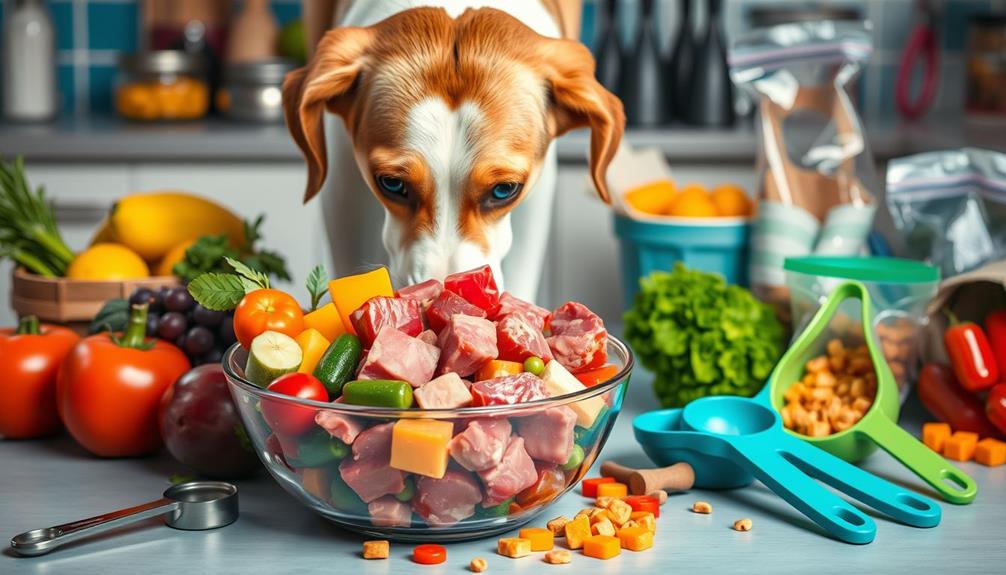
Shifting your dog to raw food requires a gradual approach to avoid digestive issues.
Start by mixing raw meals with their usual kibble to enhance appeal and ease them into the new diet.
It's important to monitor your dog's health during this shift, looking for any signs of discomfort or changes in behavior, as proper hamster care involves understanding dietary needs.
Keep an eye on your dog's preferences, as this will help you adjust their meals to guarantee they're more willing to eat.
Gradual Dietary Changes
As you consider moving your dog to a raw food diet, it's crucial to make gradual dietary changes that will ease the shift. Start by replacing one dry meal at a time with raw food. This approach helps prevent digestive upset and allows your dog's system to adjust smoothly.
Mixing raw food with kibble can also ease the transition, as it introduces new textures and flavors while still offering the comfort of familiar food. Additionally, setting a budget for pet food can assist in managing costs during this change, guaranteeing you can provide quality nutrition without overspending on your dog's diet a budget plan.
During this change, it's vital to closely monitor your dog's response. Adjust portion sizes based on their weight and activity level to make sure they're getting adequate nutrition.
Offering a variety of protein sources—like chicken, beef, or fish—can spark interest and acceptance, as dogs often have unique taste preferences.
Enhance Meal Appeal
Enhancing your dog's meal appeal is key to successfully shifting to a raw food diet. You can entice your dog by mixing raw food with kibble, which introduces new textures and flavors gradually. Adding goat's milk can boost palatability and is gentler on digestion than cow's milk. Slightly warming thawed raw patties enhances aroma and flavor, encouraging your dog to try the food.
Experimenting with different forms of raw food—such as patties, chunks, or ground options—can help you find the preferred consistency for your dog. Offering a variety of protein sources, like chicken, beef, or lamb, allows you to discover your dog's taste preferences and increase acceptance of raw food.
Here's a simple table to summarize these tips:
| Method | Benefit | Example Protein Sources |
|---|---|---|
| Mix with kibble | Introduces new textures | Chicken, beef |
| Add goat's milk | Improves palatability | Lamb, turkey |
| Slightly warm patties | Enhances aroma and flavor | Duck, fish |
| Experiment with forms | Identifies preferred consistency | Pork, venison |
These strategies can make meal times more appealing for your dog!
Monitor Dog's Preferences
Monitoring your dog's preferences plays a significant role in getting them to embrace a raw food diet. Every dog has unique tastes, and understanding these can make the change smoother.
Here are some steps to take into account:
- Experiment with Protein Sources: Try different meats like chicken, beef, or lamb to see which one your dog prefers, as silly tantrums often occur during meal times, reflecting their preferences vividly.
- Adjust Temperature: Warm the raw food slightly to enhance its aroma and flavor, as many dogs are more attracted to meals served at a warmer temperature.
- Add Meal Toppers: Incorporate healthy treats or bone broth to entice your dog. These additions can boost the flavor and nutritional value of the raw food.
- Establish a Feeding Routine: Create a consistent meal schedule to help your dog adjust to the new diet, reducing anxiety around feeding time.
Enhancing Mealtime Experience
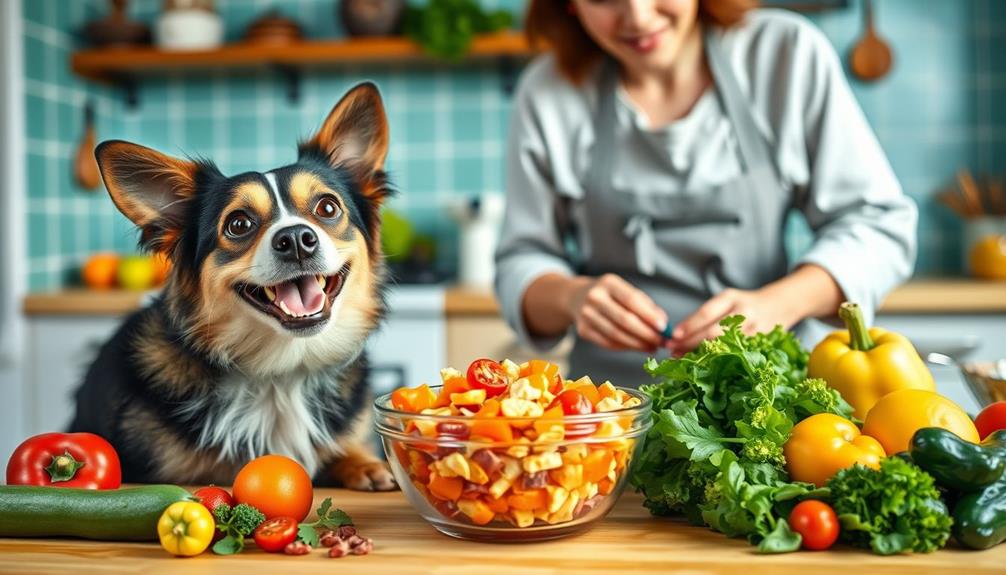
Creating a positive mealtime atmosphere can make all the difference for your dog when introducing raw food. Start by establishing a consistent feeding routine with set mealtimes in a calm environment. This reduces distractions, allowing your dog to feel more comfortable while eating.
To enhance the mealtime experience further, consider incorporating healthy toppers like cooked veggies or favorite treats. These additions can make raw food more enticing for picky eaters. Additionally, exploring primitive weapons for modern survival can help foster creativity and adaptability, which may also translate to your approach in making mealtime enjoyable.
Engaging your dog with enrichment activities during feeding can also boost their interest. Use toys or puzzles to stimulate their minds, turning mealtime into an enjoyable experience. Remember to monitor your dog for signs of adjustment; occasional skipped meals may just be their response to new food rather than a health issue.
Lastly, use positive reinforcement during mealtime. Praise or reward your dog for eating, helping to establish better eating habits and encourage consistent raw food consumption. By focusing on these strategies, you can enhance your dog's mealtime experience, making raw food more appealing and enjoyable for them.
Tips to Encourage Raw Consumption
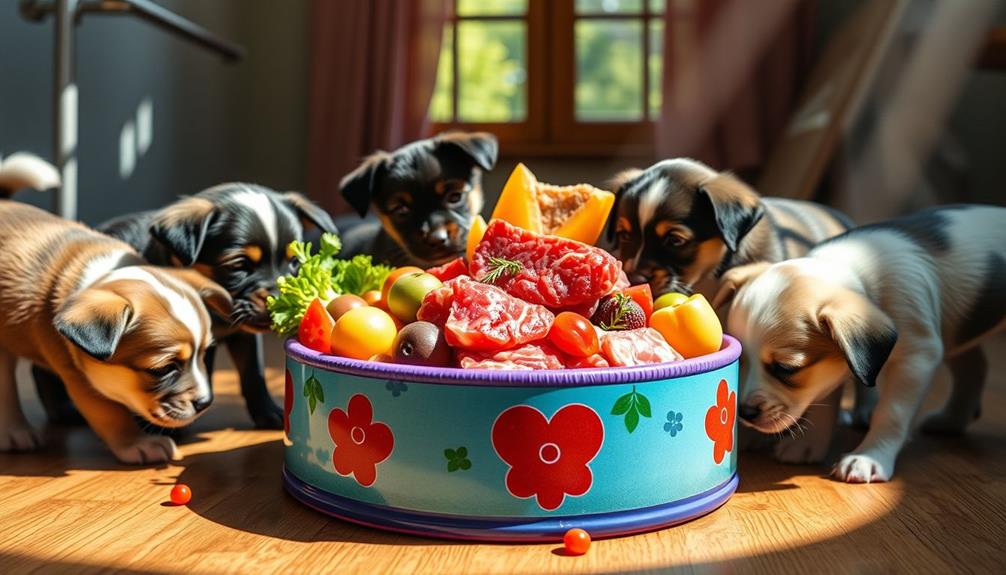
To get your dog to enjoy raw food, start by enhancing its appeal with tasty additions like warm bone broth or goat's milk.
Incorporating healthy dog snacks can further entice your pup and make the shift smoother.
Gradually change to raw meals by mixing them with kibble, making it easier for your pup to adjust.
Don't forget to experiment with different protein sources to find out what your dog loves best.
Enhance Food Appeal
Enhancing the appeal of raw food can make a significant difference for picky eaters. Here are some effective tips to encourage your dog to embrace their new diet:
1. Experiment with Protein Sources: Dogs have individual taste preferences. Switching up proteins like chicken, beef, or fish can spark their interest in raw food.
Additionally, consider adding essential oils like eucalyptus oil for their invigorating scent, which can stimulate appetite.
2. Add Meal Toppers: Incorporate healthy meal toppers like cooked vegetables or their favorite treats. This boosts flavor and can make raw meals more enticing.
3. Serve Warmed Food: Slightly warming the raw food enhances its aroma and texture. Many dogs prefer warmer meals, so this simple step can increase their willingness to eat.
4. Mix with Kibble: During the shift, try mixing a small amount of kibble with the raw food. This helps bridge the gap between the familiar taste of kibble and the new raw diet.
Additionally, consider incorporating bone broth into raw meals. It adds moisture and flavor, making it even more appealing for your dog.
With these strategies, you can transform your dog's attitude towards raw food!
Gradual Transition Process
Introducing raw food to your dog's diet can be a process, but taking it slow can make all the difference. A gradual shift is key to helping your dog adjust to raw food without upsetting their digestive system. Start by mixing raw food with their kibble, replacing one meal at a time. This allows them to explore new textures and flavors.
Here's a simple guide for your shift:
| Step | Action |
|---|---|
| Start Slow | Mix raw food with kibble, one meal at a time. |
| Monitor Responses | Watch for any digestive issues; patience is essential. |
| Establish Routine | Keep a consistent feeding routine and avoid leaving food out. |
Serve raw food at room temperature or slightly warmed to enhance aroma and flavor, as many dogs prefer it this way. Don't hesitate to experiment with different protein sources and meal toppers like warm bone broth or cooked veggies to boost the appeal. By closely monitoring your dog's response and being consistent, you'll encourage a smoother shift to raw food.
Experiment With Proteins
When switching to a raw diet, experimenting with different protein sources can be a game changer for your dog's acceptance. Dogs have unique taste preferences, so finding the right proteins can entice them to embrace raw food. Here are some proteins to take into account:
- Chicken – Often a favorite, it's mild and easy to digest.
- Beef – Rich in flavor and packed with nutrients, it can be very appealing.
- Lamb – A great option for dogs with sensitivities to other meats.
- Turkey – Lean and tasty, it's a good alternative for picky eaters.
In addition, a well-balanced diet is essential, as a juice diet may lead to nutrient deficiencies if not properly managed.
While you're experimenting, keep an eye on your dog's reactions. Some proteins may cause stomach upset or allergies. If your dog previously ate kibble, they might need time to adjust to the taste and texture of raw proteins.
Mixing raw proteins with enticing toppings or warming the food slightly can enhance its palatability. A rotational diet not only keeps mealtime interesting but also boosts nutrient intake.
When to Consult a Veterinarian

How can you tell if your dog's refusal to eat raw food is a cause for concern? If your dog skips a meal or refuses to eat for more than 24 hours, it's time to reflect on a consultation with a veterinarian.
Sudden changes in appetite can signal underlying health issues, especially if accompanied by weight loss, lethargy, or behavior changes. It's also important to be aware of any potential financial considerations for elderly care if your dog is a senior, as their dietary needs may change with age.
Puppies and dogs with existing health conditions need regular meals, so it's essential not to overlook their dietary needs. If your dog previously enjoyed raw food but now turns away from it, this could indicate dental problems or gastrointestinal issues that require professional evaluation.
Moreover, understanding your dog's specific dietary requirements and potential allergies is key to achieving nutritional balance. A veterinarian can help identify these factors and suggest tailored strategies to improve your dog's appetite.
Don't hesitate to reach out for help; your dog's health and well-being should always come first. If you notice any concerning signs, seeking veterinary advice can guarantee you address any underlying issues promptly.
Common Concerns About Raw Feeding
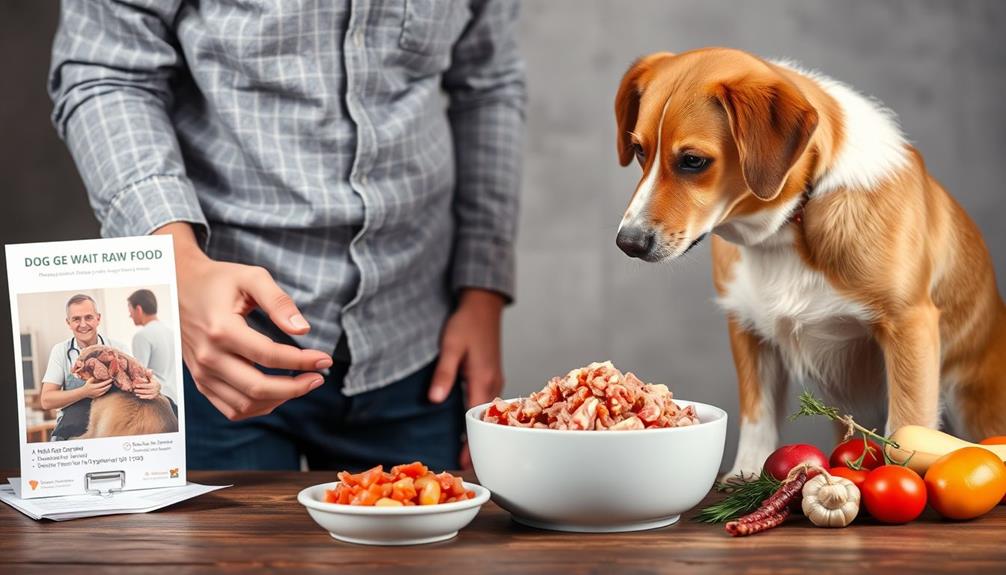
Many dog owners have common concerns about shifting to a raw feeding diet. It's understandable to be cautious, especially with the following issues in mind:
- Bacterial Contamination: Owners worry about pathogens like Salmonella that can be present in raw food, which might pose health risks to both pets and humans. It's important to guarantee proper food handling and hygiene to mitigate these risks, similar to the precautions taken in mammography screening processes.
- Nutritional Balance: You might question whether a raw diet provides all the essential nutrients needed for your dog's health, especially if they've been on processed foods.
- Choking Hazards: Concerns about bones in raw diets leading to potential choking hazards can make you hesitant, causing you to stick with safer, processed options.
- Taste and Texture: If your pup is used to kibble, they might resist raw food due to its unfamiliar taste and texture, leading to reluctance in trying it.
Regular veterinary check-ups are essential when changing to a raw diet. They can help monitor your dog's health, address nutritional balance, and tackle any food refusal issues.
Resources for Raw Feeding Support

Where can you find reliable support for raw feeding? Start by exploring educational materials like books and guides that explain the principles of a raw diet. These resources guarantee you're well-informed about adapting your dog to raw feeding.
Don't overlook online communities. Joining forums and social media groups connects you with other pet owners who've successfully made the switch. They can share experiences, tips, and advice that might help ease your concerns.
Consulting with holistic veterinarians can also be beneficial. They provide personalized guidance tailored to your dog's specific health needs during the adjustment. Their expertise can help you navigate any challenges you face.
Additionally, find local suppliers or co-ops specializing in raw food. These businesses not only offer quality ingredients but also foster community support among fellow raw feeders.
Lastly, consider checking out video resources. Educational videos and webinars can visually demonstrate how to prepare and serve raw meals, enhancing your understanding and confidence in raw feeding.
With these resources at your disposal, you'll feel more equipped to support your dog's journey to a raw diet.
Frequently Asked Questions
What if My Raw Fed Dog Is Refusing to Eat?
If your raw-fed dog's refusing to eat, try introducing variety in their diet or warming the food slightly. Check for stressors in their environment, and make certain you're not overfeeding with treats or scraps. In addition, consider consulting with a veterinarian to rule out any underlying health issues. It’s also important to be aware of the potential risks associated with feeding raw food and pancreatitis in dogs. While a raw diet can be beneficial for some dogs, it’s important to carefully research and monitor their overall health and nutritional needs. Always consult with a professional to ensure you’re providing the best diet for your pet. When transitioning your dog to a raw diet, remember to do so gradually to avoid digestive upset. Start by mixing small amounts of raw food into their regular diet and slowly increasing the ratio over time. Look for expert tips for dog’s diet transition to ensure a smooth and successful change. Some helpful tips may include balancing the diet with a variety of protein sources, incorporating fruits and vegetables, and ensuring proper supplements are included to meet all of their nutritional needs. Always monitor your dog’s health and behavior during the transition and make adjustments as needed with the guidance of a professional.
How Can I Encourage My Dog to Eat Raw Food?
To encourage your dog to eat raw food, mix it with their kibble, warm it slightly, and try different proteins. Establish a routine and remove uneaten food after 20 minutes to promote better eating habits.
Do Some Dogs Not Do Well on Raw Food?
Some dogs, like picky eaters at a buffet, struggle with raw food. Their digestive systems might rebel, or they could have allergies, making them turn their noses up at unfamiliar textures and flavors.
Do Picky Dogs Like Raw Food?
Picky dogs often don't like raw food at first. They're used to kibble's texture and temperature. With patience and experimentation, you can find enticing options that might change their minds and encourage acceptance.
Conclusion
In the journey of feeding your dog raw food, don't lose heart—think of it as training for a grand adventure, much like Odysseus steering his way home. By understanding your dog's unique appetite challenges and using the tips provided, you can transform mealtime into a rewarding experience. Remember, patience is key. If concerns persist, don't hesitate to reach out to a veterinarian. Your furry companion's health and happiness are worth every effort you make!


